Applying UDL: A Teaching Unit on Heroes and Villains for All Learners
VerifiedAdded on 2023/06/12
|5
|1355
|150
Project
AI Summary
This project outlines the application of the Universal Design for Learning (UDL) framework to a teaching unit focused on 'Heroes and Villains,' designed for a diverse classroom comprising students with physical disabilities, vision impairments, gifted abilities, and those without additional needs. The project details the unit's content, which includes exploring heroic and villainous characteristics, origin stories, and creating trading cards. It provides a rationale for adopting an accessible education approach, emphasizing inclusivity and proactive elimination of learning barriers. Assessment methods are tailored to individual learner strengths, including assignments, presentations, research papers, and examinations. The goal is to create an inclusive learning environment that optimizes autonomy and choice, ensuring all students can achieve learning outcomes with appropriate support. The project also references various studies supporting the UDL framework and accessible education principles.
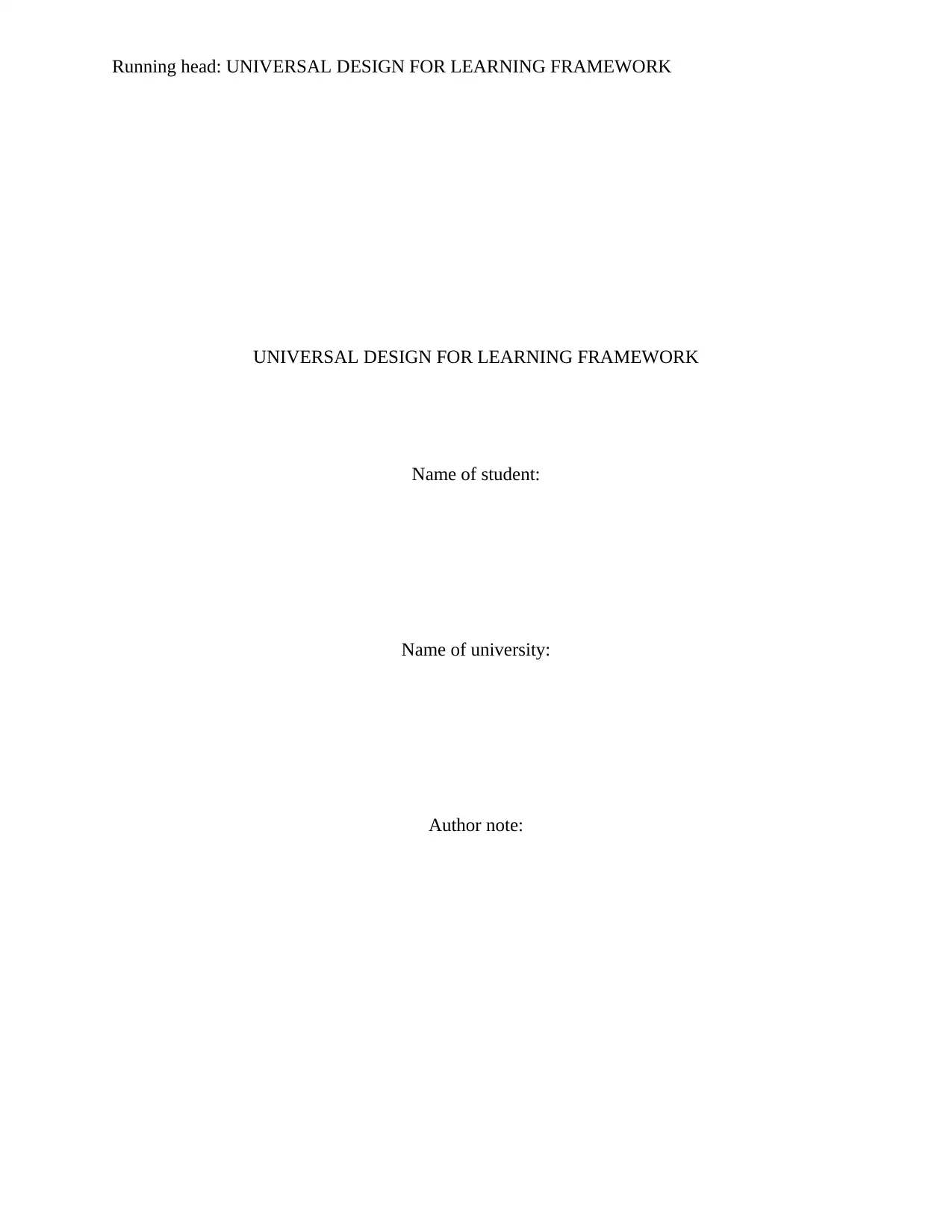
Running head: UNIVERSAL DESIGN FOR LEARNING FRAMEWORK
UNIVERSAL DESIGN FOR LEARNING FRAMEWORK
Name of student:
Name of university:
Author note:
UNIVERSAL DESIGN FOR LEARNING FRAMEWORK
Name of student:
Name of university:
Author note:
Paraphrase This Document
Need a fresh take? Get an instant paraphrase of this document with our AI Paraphraser
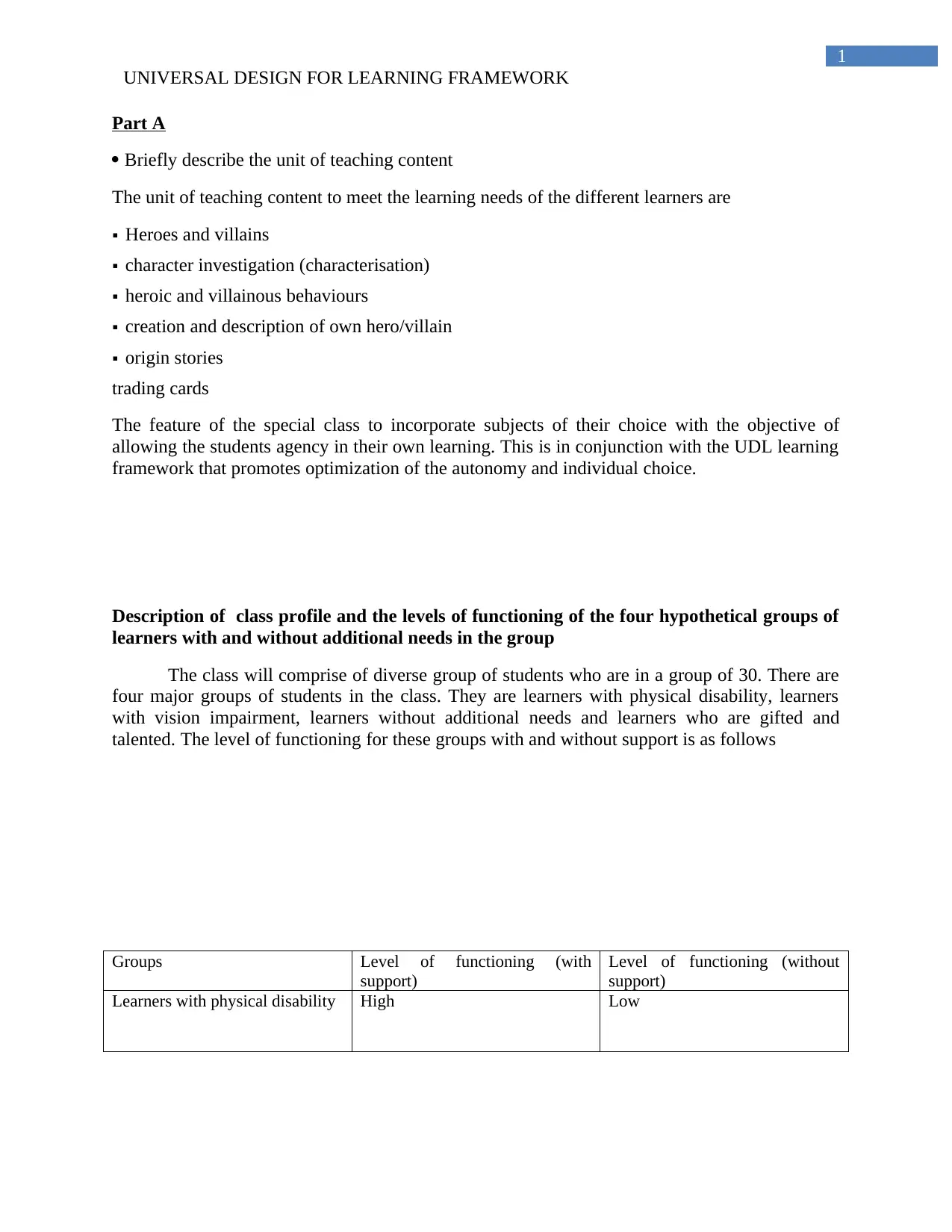
1
UNIVERSAL DESIGN FOR LEARNING FRAMEWORK
Part A
Briefly describe the unit of teaching content
The unit of teaching content to meet the learning needs of the different learners are
Heroes and villains
character investigation (characterisation)
heroic and villainous behaviours
creation and description of own hero/villain
origin stories
trading cards
The feature of the special class to incorporate subjects of their choice with the objective of
allowing the students agency in their own learning. This is in conjunction with the UDL learning
framework that promotes optimization of the autonomy and individual choice.
Description of class profile and the levels of functioning of the four hypothetical groups of
learners with and without additional needs in the group
The class will comprise of diverse group of students who are in a group of 30. There are
four major groups of students in the class. They are learners with physical disability, learners
with vision impairment, learners without additional needs and learners who are gifted and
talented. The level of functioning for these groups with and without support is as follows
Groups Level of functioning (with
support)
Level of functioning (without
support)
Learners with physical disability High Low
UNIVERSAL DESIGN FOR LEARNING FRAMEWORK
Part A
Briefly describe the unit of teaching content
The unit of teaching content to meet the learning needs of the different learners are
Heroes and villains
character investigation (characterisation)
heroic and villainous behaviours
creation and description of own hero/villain
origin stories
trading cards
The feature of the special class to incorporate subjects of their choice with the objective of
allowing the students agency in their own learning. This is in conjunction with the UDL learning
framework that promotes optimization of the autonomy and individual choice.
Description of class profile and the levels of functioning of the four hypothetical groups of
learners with and without additional needs in the group
The class will comprise of diverse group of students who are in a group of 30. There are
four major groups of students in the class. They are learners with physical disability, learners
with vision impairment, learners without additional needs and learners who are gifted and
talented. The level of functioning for these groups with and without support is as follows
Groups Level of functioning (with
support)
Level of functioning (without
support)
Learners with physical disability High Low
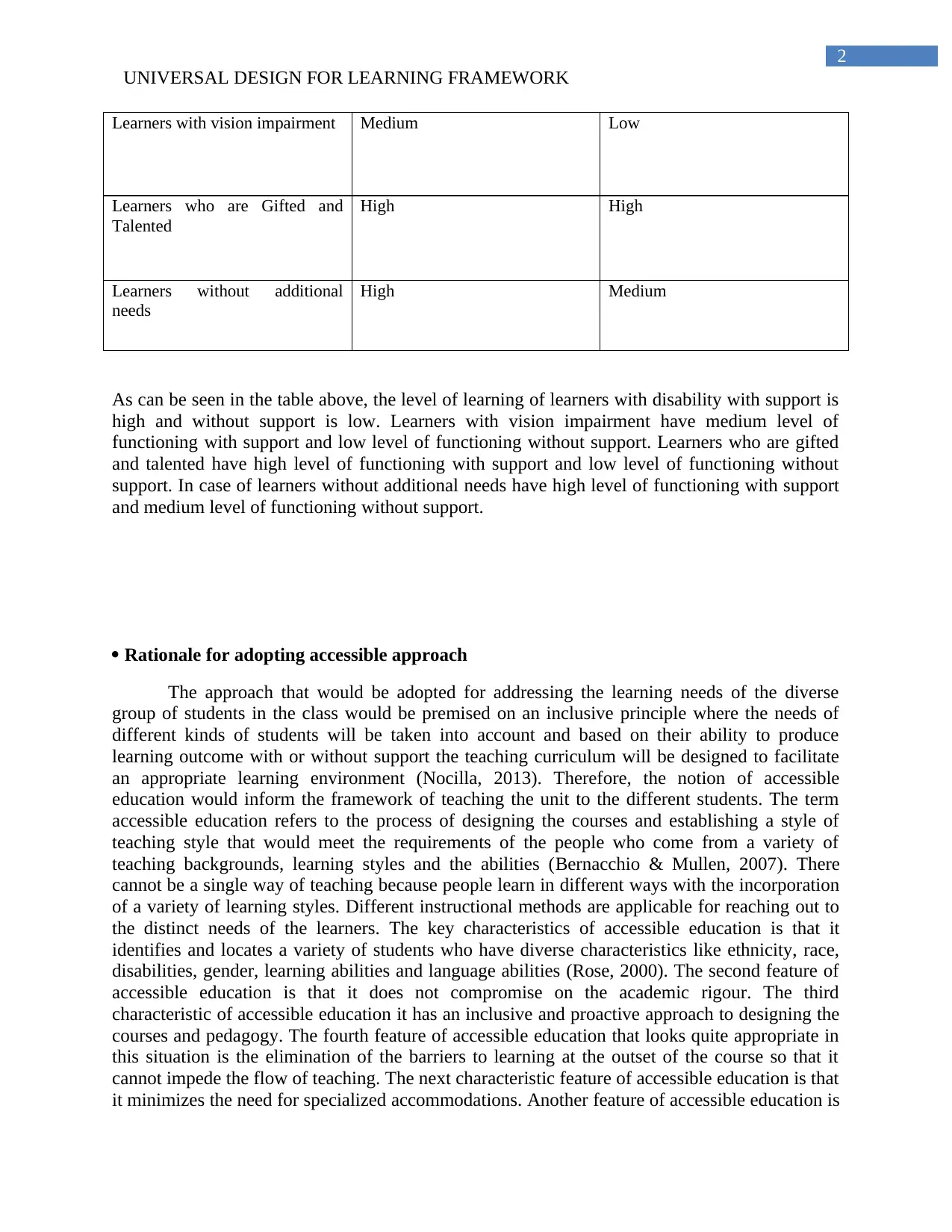
2
UNIVERSAL DESIGN FOR LEARNING FRAMEWORK
Learners with vision impairment Medium Low
Learners who are Gifted and
Talented
High High
Learners without additional
needs
High Medium
As can be seen in the table above, the level of learning of learners with disability with support is
high and without support is low. Learners with vision impairment have medium level of
functioning with support and low level of functioning without support. Learners who are gifted
and talented have high level of functioning with support and low level of functioning without
support. In case of learners without additional needs have high level of functioning with support
and medium level of functioning without support.
Rationale for adopting accessible approach
The approach that would be adopted for addressing the learning needs of the diverse
group of students in the class would be premised on an inclusive principle where the needs of
different kinds of students will be taken into account and based on their ability to produce
learning outcome with or without support the teaching curriculum will be designed to facilitate
an appropriate learning environment (Nocilla, 2013). Therefore, the notion of accessible
education would inform the framework of teaching the unit to the different students. The term
accessible education refers to the process of designing the courses and establishing a style of
teaching style that would meet the requirements of the people who come from a variety of
teaching backgrounds, learning styles and the abilities (Bernacchio & Mullen, 2007). There
cannot be a single way of teaching because people learn in different ways with the incorporation
of a variety of learning styles. Different instructional methods are applicable for reaching out to
the distinct needs of the learners. The key characteristics of accessible education is that it
identifies and locates a variety of students who have diverse characteristics like ethnicity, race,
disabilities, gender, learning abilities and language abilities (Rose, 2000). The second feature of
accessible education is that it does not compromise on the academic rigour. The third
characteristic of accessible education it has an inclusive and proactive approach to designing the
courses and pedagogy. The fourth feature of accessible education that looks quite appropriate in
this situation is the elimination of the barriers to learning at the outset of the course so that it
cannot impede the flow of teaching. The next characteristic feature of accessible education is that
it minimizes the need for specialized accommodations. Another feature of accessible education is
UNIVERSAL DESIGN FOR LEARNING FRAMEWORK
Learners with vision impairment Medium Low
Learners who are Gifted and
Talented
High High
Learners without additional
needs
High Medium
As can be seen in the table above, the level of learning of learners with disability with support is
high and without support is low. Learners with vision impairment have medium level of
functioning with support and low level of functioning without support. Learners who are gifted
and talented have high level of functioning with support and low level of functioning without
support. In case of learners without additional needs have high level of functioning with support
and medium level of functioning without support.
Rationale for adopting accessible approach
The approach that would be adopted for addressing the learning needs of the diverse
group of students in the class would be premised on an inclusive principle where the needs of
different kinds of students will be taken into account and based on their ability to produce
learning outcome with or without support the teaching curriculum will be designed to facilitate
an appropriate learning environment (Nocilla, 2013). Therefore, the notion of accessible
education would inform the framework of teaching the unit to the different students. The term
accessible education refers to the process of designing the courses and establishing a style of
teaching style that would meet the requirements of the people who come from a variety of
teaching backgrounds, learning styles and the abilities (Bernacchio & Mullen, 2007). There
cannot be a single way of teaching because people learn in different ways with the incorporation
of a variety of learning styles. Different instructional methods are applicable for reaching out to
the distinct needs of the learners. The key characteristics of accessible education is that it
identifies and locates a variety of students who have diverse characteristics like ethnicity, race,
disabilities, gender, learning abilities and language abilities (Rose, 2000). The second feature of
accessible education is that it does not compromise on the academic rigour. The third
characteristic of accessible education it has an inclusive and proactive approach to designing the
courses and pedagogy. The fourth feature of accessible education that looks quite appropriate in
this situation is the elimination of the barriers to learning at the outset of the course so that it
cannot impede the flow of teaching. The next characteristic feature of accessible education is that
it minimizes the need for specialized accommodations. Another feature of accessible education is
⊘ This is a preview!⊘
Do you want full access?
Subscribe today to unlock all pages.

Trusted by 1+ million students worldwide
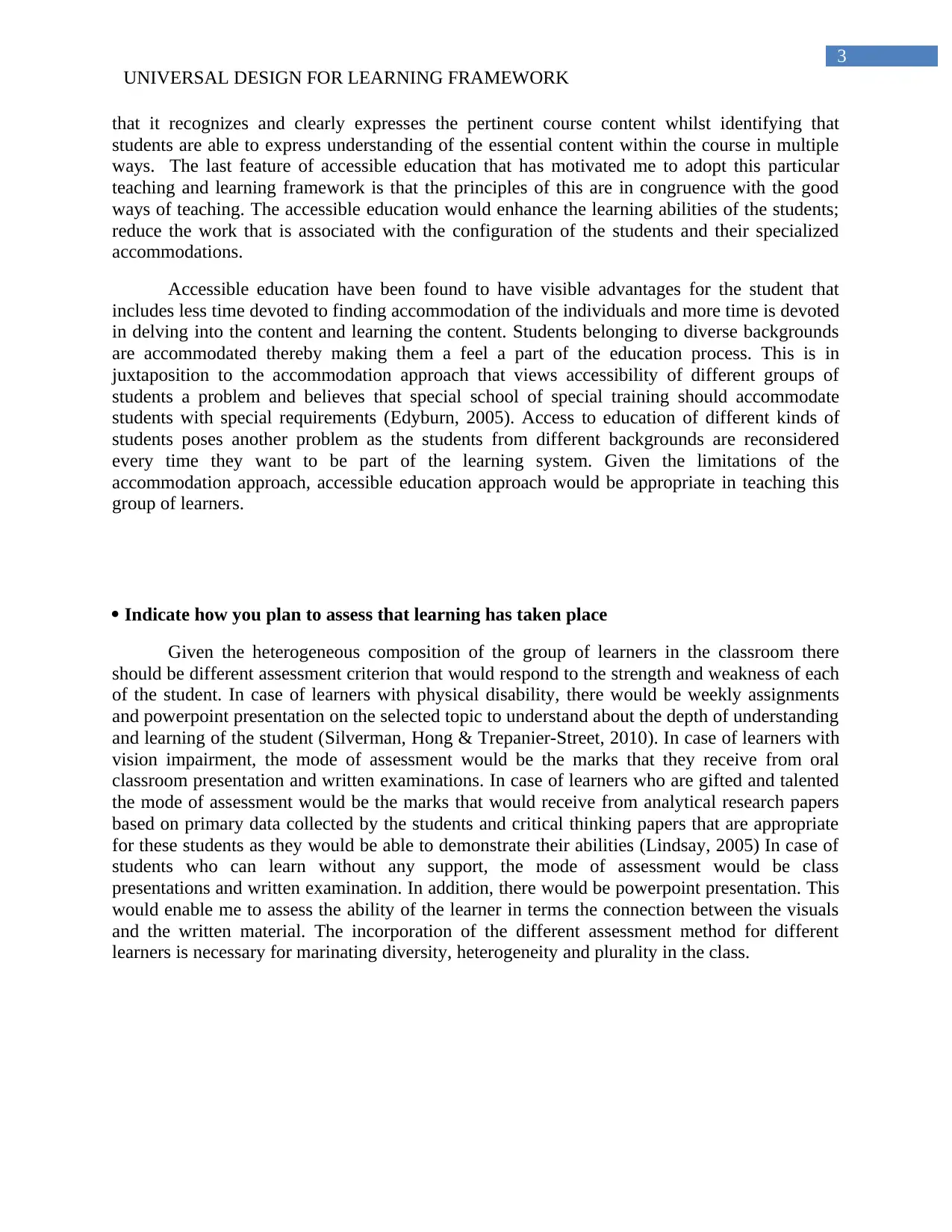
3
UNIVERSAL DESIGN FOR LEARNING FRAMEWORK
that it recognizes and clearly expresses the pertinent course content whilst identifying that
students are able to express understanding of the essential content within the course in multiple
ways. The last feature of accessible education that has motivated me to adopt this particular
teaching and learning framework is that the principles of this are in congruence with the good
ways of teaching. The accessible education would enhance the learning abilities of the students;
reduce the work that is associated with the configuration of the students and their specialized
accommodations.
Accessible education have been found to have visible advantages for the student that
includes less time devoted to finding accommodation of the individuals and more time is devoted
in delving into the content and learning the content. Students belonging to diverse backgrounds
are accommodated thereby making them a feel a part of the education process. This is in
juxtaposition to the accommodation approach that views accessibility of different groups of
students a problem and believes that special school of special training should accommodate
students with special requirements (Edyburn, 2005). Access to education of different kinds of
students poses another problem as the students from different backgrounds are reconsidered
every time they want to be part of the learning system. Given the limitations of the
accommodation approach, accessible education approach would be appropriate in teaching this
group of learners.
Indicate how you plan to assess that learning has taken place
Given the heterogeneous composition of the group of learners in the classroom there
should be different assessment criterion that would respond to the strength and weakness of each
of the student. In case of learners with physical disability, there would be weekly assignments
and powerpoint presentation on the selected topic to understand about the depth of understanding
and learning of the student (Silverman, Hong & Trepanier-Street, 2010). In case of learners with
vision impairment, the mode of assessment would be the marks that they receive from oral
classroom presentation and written examinations. In case of learners who are gifted and talented
the mode of assessment would be the marks that would receive from analytical research papers
based on primary data collected by the students and critical thinking papers that are appropriate
for these students as they would be able to demonstrate their abilities (Lindsay, 2005) In case of
students who can learn without any support, the mode of assessment would be class
presentations and written examination. In addition, there would be powerpoint presentation. This
would enable me to assess the ability of the learner in terms the connection between the visuals
and the written material. The incorporation of the different assessment method for different
learners is necessary for marinating diversity, heterogeneity and plurality in the class.
UNIVERSAL DESIGN FOR LEARNING FRAMEWORK
that it recognizes and clearly expresses the pertinent course content whilst identifying that
students are able to express understanding of the essential content within the course in multiple
ways. The last feature of accessible education that has motivated me to adopt this particular
teaching and learning framework is that the principles of this are in congruence with the good
ways of teaching. The accessible education would enhance the learning abilities of the students;
reduce the work that is associated with the configuration of the students and their specialized
accommodations.
Accessible education have been found to have visible advantages for the student that
includes less time devoted to finding accommodation of the individuals and more time is devoted
in delving into the content and learning the content. Students belonging to diverse backgrounds
are accommodated thereby making them a feel a part of the education process. This is in
juxtaposition to the accommodation approach that views accessibility of different groups of
students a problem and believes that special school of special training should accommodate
students with special requirements (Edyburn, 2005). Access to education of different kinds of
students poses another problem as the students from different backgrounds are reconsidered
every time they want to be part of the learning system. Given the limitations of the
accommodation approach, accessible education approach would be appropriate in teaching this
group of learners.
Indicate how you plan to assess that learning has taken place
Given the heterogeneous composition of the group of learners in the classroom there
should be different assessment criterion that would respond to the strength and weakness of each
of the student. In case of learners with physical disability, there would be weekly assignments
and powerpoint presentation on the selected topic to understand about the depth of understanding
and learning of the student (Silverman, Hong & Trepanier-Street, 2010). In case of learners with
vision impairment, the mode of assessment would be the marks that they receive from oral
classroom presentation and written examinations. In case of learners who are gifted and talented
the mode of assessment would be the marks that would receive from analytical research papers
based on primary data collected by the students and critical thinking papers that are appropriate
for these students as they would be able to demonstrate their abilities (Lindsay, 2005) In case of
students who can learn without any support, the mode of assessment would be class
presentations and written examination. In addition, there would be powerpoint presentation. This
would enable me to assess the ability of the learner in terms the connection between the visuals
and the written material. The incorporation of the different assessment method for different
learners is necessary for marinating diversity, heterogeneity and plurality in the class.
Paraphrase This Document
Need a fresh take? Get an instant paraphrase of this document with our AI Paraphraser
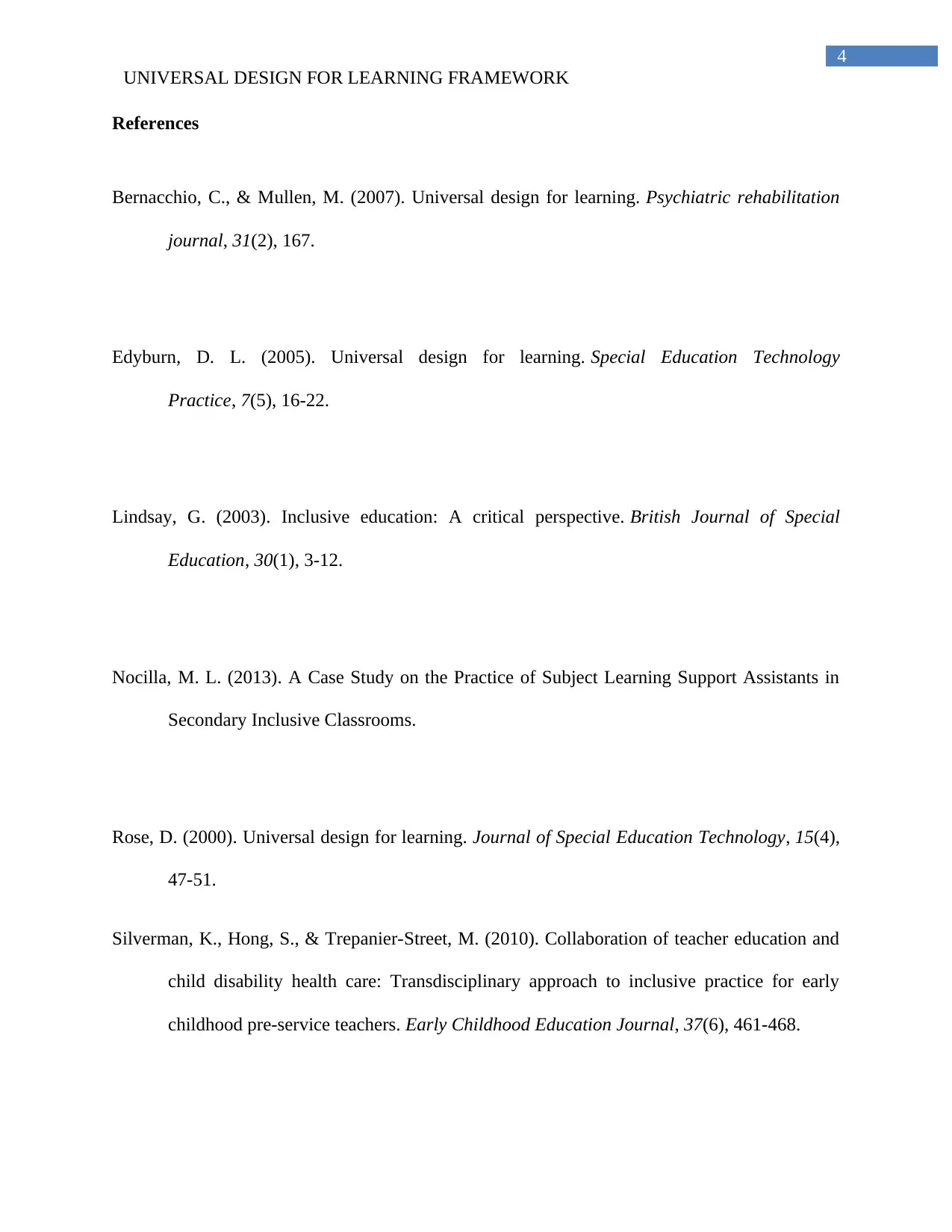
4
UNIVERSAL DESIGN FOR LEARNING FRAMEWORK
References
Bernacchio, C., & Mullen, M. (2007). Universal design for learning. Psychiatric rehabilitation
journal, 31(2), 167.
Edyburn, D. L. (2005). Universal design for learning. Special Education Technology
Practice, 7(5), 16-22.
Lindsay, G. (2003). Inclusive education: A critical perspective. British Journal of Special
Education, 30(1), 3-12.
Nocilla, M. L. (2013). A Case Study on the Practice of Subject Learning Support Assistants in
Secondary Inclusive Classrooms.
Rose, D. (2000). Universal design for learning. Journal of Special Education Technology, 15(4),
47-51.
Silverman, K., Hong, S., & Trepanier-Street, M. (2010). Collaboration of teacher education and
child disability health care: Transdisciplinary approach to inclusive practice for early
childhood pre-service teachers. Early Childhood Education Journal, 37(6), 461-468.
UNIVERSAL DESIGN FOR LEARNING FRAMEWORK
References
Bernacchio, C., & Mullen, M. (2007). Universal design for learning. Psychiatric rehabilitation
journal, 31(2), 167.
Edyburn, D. L. (2005). Universal design for learning. Special Education Technology
Practice, 7(5), 16-22.
Lindsay, G. (2003). Inclusive education: A critical perspective. British Journal of Special
Education, 30(1), 3-12.
Nocilla, M. L. (2013). A Case Study on the Practice of Subject Learning Support Assistants in
Secondary Inclusive Classrooms.
Rose, D. (2000). Universal design for learning. Journal of Special Education Technology, 15(4),
47-51.
Silverman, K., Hong, S., & Trepanier-Street, M. (2010). Collaboration of teacher education and
child disability health care: Transdisciplinary approach to inclusive practice for early
childhood pre-service teachers. Early Childhood Education Journal, 37(6), 461-468.
1 out of 5
Related Documents
Your All-in-One AI-Powered Toolkit for Academic Success.
+13062052269
info@desklib.com
Available 24*7 on WhatsApp / Email
![[object Object]](/_next/static/media/star-bottom.7253800d.svg)
Unlock your academic potential
Copyright © 2020–2025 A2Z Services. All Rights Reserved. Developed and managed by ZUCOL.





